 Having a teenage girl has definitely made me think more about jewelry than I have for a long time. I used to care about jewelry when I was still dating……a million years ago, but now I think my husband is just glad if I show up clean and not smelling of paint. To be completely honest, he’ll still take me out dirty and smelly but only because he doesn’t have many other offers……..not that I do. Anyway, back to the jewelry. I got an idea for a hanging jewelry organizer when I was rummaging through my junk and I thought I’d share the steps I went through to create it, just in case you have some junk laying around too…..oh, and some jewelry. In the above photo you can see what I started with. The frame and back board were originally together as a piece of “art” from Ross. The “art” was ugly so I pulled it out and used the back. I bought it at an estate liquidator place for $5, which is high (I think the guy thought it was “art” too) but he gave me two others for $1 so I’m telling myself I paid $2 for it. Ah, the rationalizations of the hoarder mind. The ugly metal knobs are in two pieces and I found them at a thrift store for 50 cents each. I think the metal screen is used for radiators, but since we don’t have those in San Diego, that may be an urban legend. I found it in my friend’s garage and she let me take it for free. Yay!
Having a teenage girl has definitely made me think more about jewelry than I have for a long time. I used to care about jewelry when I was still dating……a million years ago, but now I think my husband is just glad if I show up clean and not smelling of paint. To be completely honest, he’ll still take me out dirty and smelly but only because he doesn’t have many other offers……..not that I do. Anyway, back to the jewelry. I got an idea for a hanging jewelry organizer when I was rummaging through my junk and I thought I’d share the steps I went through to create it, just in case you have some junk laying around too…..oh, and some jewelry. In the above photo you can see what I started with. The frame and back board were originally together as a piece of “art” from Ross. The “art” was ugly so I pulled it out and used the back. I bought it at an estate liquidator place for $5, which is high (I think the guy thought it was “art” too) but he gave me two others for $1 so I’m telling myself I paid $2 for it. Ah, the rationalizations of the hoarder mind. The ugly metal knobs are in two pieces and I found them at a thrift store for 50 cents each. I think the metal screen is used for radiators, but since we don’t have those in San Diego, that may be an urban legend. I found it in my friend’s garage and she let me take it for free. Yay! 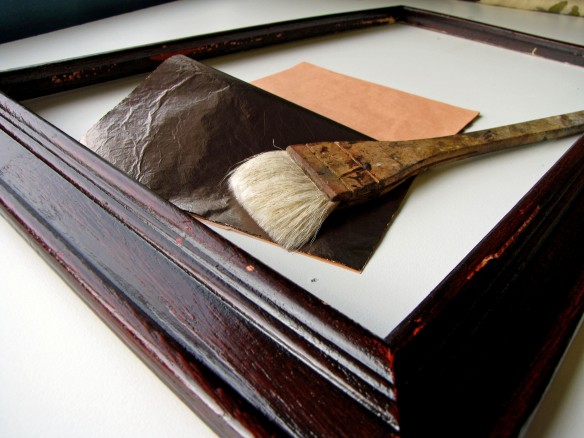 I decided to gild the frame with metal leaf. The first step in gilding is applying gilding size and I always use Rolco Aquasize which is water-based and dries quickly. Gilding size is a watery adhesive that you brush on. The photo above shows the frame after the size was applied, which is why it’s shiny. The metal leaf I used is called Celestial Leaf and the color is Moonbeam. This is a variegated metal leaf, so the color is inconsistent, which I actually love. Celestial Leaf comes in books and each sheet is applied individually.
I decided to gild the frame with metal leaf. The first step in gilding is applying gilding size and I always use Rolco Aquasize which is water-based and dries quickly. Gilding size is a watery adhesive that you brush on. The photo above shows the frame after the size was applied, which is why it’s shiny. The metal leaf I used is called Celestial Leaf and the color is Moonbeam. This is a variegated metal leaf, so the color is inconsistent, which I actually love. Celestial Leaf comes in books and each sheet is applied individually. 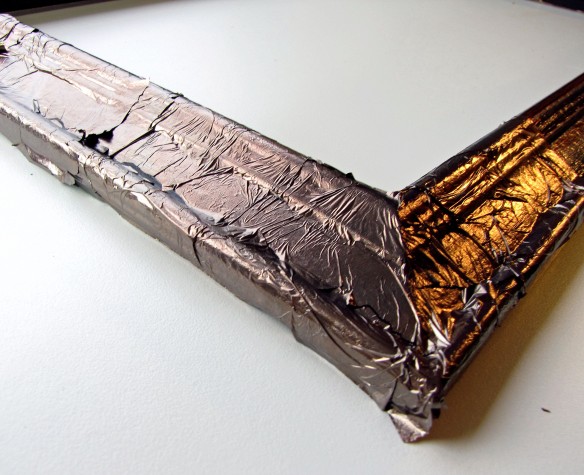 After the size has dried and become tacky, lay a piece of leaf on the surface and push it in to the crevices with a soft brush. Try to not touch the leaf with your bare hands as the oil from your hands can discolor the leaf. When you have the entire surface covered in leaf, smooth it out with a sheepskin pad. If you don’t have a sheepskin pad you can use a really soft rag, but just know that it may scratch the leaf if it’s not truly soft.
After the size has dried and become tacky, lay a piece of leaf on the surface and push it in to the crevices with a soft brush. Try to not touch the leaf with your bare hands as the oil from your hands can discolor the leaf. When you have the entire surface covered in leaf, smooth it out with a sheepskin pad. If you don’t have a sheepskin pad you can use a really soft rag, but just know that it may scratch the leaf if it’s not truly soft.  When the leaf is all shiny and pretty you can spray a coat of varnish on it to protect it from tarnish. I really recommend this step if it will be hung near a shower.
When the leaf is all shiny and pretty you can spray a coat of varnish on it to protect it from tarnish. I really recommend this step if it will be hung near a shower. 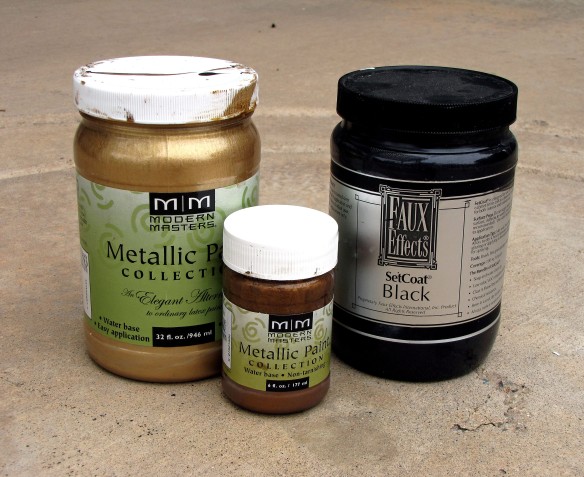 Moving on to the knobs….after cleaning them well, I primed them with Faux Effects Black SetCoat, but you could use any metal primer that works with water based paint. I painted them first with with one coat of Antique Bronze metallic paint from Modern Masters and then a second coat in Pale Gold.
Moving on to the knobs….after cleaning them well, I primed them with Faux Effects Black SetCoat, but you could use any metal primer that works with water based paint. I painted them first with with one coat of Antique Bronze metallic paint from Modern Masters and then a second coat in Pale Gold. 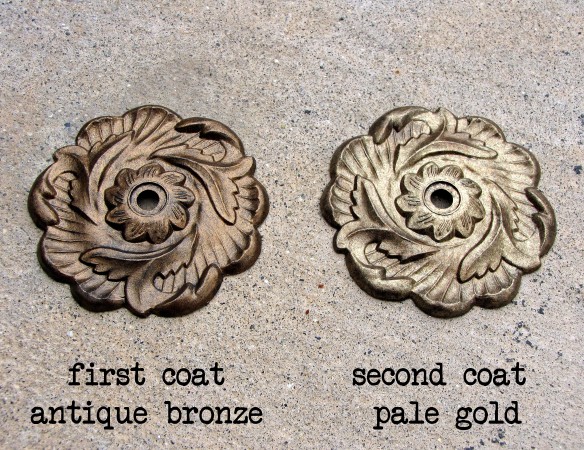 Metallic paint can be fairly transparent which is why I used a black primer. I stippled (fancy word for blobbing on light layers of paint) a thin coat of each color with a small, badly, crumpled artist brush. Use a bad brush so that the pattern is irregular. Smooth brushes leave streaks if you just brush on metallic paint. You can get a better look by stabbing it on randomly, while allowing a little of the black primer peek through.
Metallic paint can be fairly transparent which is why I used a black primer. I stippled (fancy word for blobbing on light layers of paint) a thin coat of each color with a small, badly, crumpled artist brush. Use a bad brush so that the pattern is irregular. Smooth brushes leave streaks if you just brush on metallic paint. You can get a better look by stabbing it on randomly, while allowing a little of the black primer peek through.  Now for the fun part; the backboard. I sanded the board to get rid of scratches but it was still a little uneven. I decided to hide the blemishes by using this Blue Pearl paint called Silk Soft, in the color Asian Silk. This is a metallic paint that actually has small fibers in it making it thicker and textured to the touch. To amplify this effect I applied it heavily with a rough chip brush in one direction. It looks very much like raw silk and it’s a great background for the next step.
Now for the fun part; the backboard. I sanded the board to get rid of scratches but it was still a little uneven. I decided to hide the blemishes by using this Blue Pearl paint called Silk Soft, in the color Asian Silk. This is a metallic paint that actually has small fibers in it making it thicker and textured to the touch. To amplify this effect I applied it heavily with a rough chip brush in one direction. It looks very much like raw silk and it’s a great background for the next step. 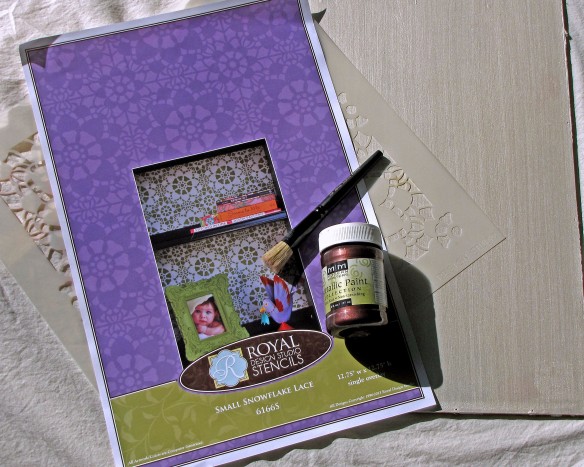 I used a new stencil from Royal Design Studio called Snowflake Lace. Royal Design just released a whole group of lace stencils that are really fun to use. I used Modern Masters metallic paint in Black Cherry and a brush from Royal Design Studio. Please don’t consider doing this with anything other than a stencil brush. Sponge brushes and artist brushes suck and should never be used for stenciling. You can use them, just don’t call me crying about it when it’s hideous. I told you not to use them. Dip your brush lightly in the paint, then rub off the excess paint in a swirling motion on a paper towel until there’s barely any paint on your brush. Swirl your brush lightly on the edges of the stencil openings, working your way into the center of each opening. Lift the stencil to check your progress as you go. It takes very little paint to leave an impression.
I used a new stencil from Royal Design Studio called Snowflake Lace. Royal Design just released a whole group of lace stencils that are really fun to use. I used Modern Masters metallic paint in Black Cherry and a brush from Royal Design Studio. Please don’t consider doing this with anything other than a stencil brush. Sponge brushes and artist brushes suck and should never be used for stenciling. You can use them, just don’t call me crying about it when it’s hideous. I told you not to use them. Dip your brush lightly in the paint, then rub off the excess paint in a swirling motion on a paper towel until there’s barely any paint on your brush. Swirl your brush lightly on the edges of the stencil openings, working your way into the center of each opening. Lift the stencil to check your progress as you go. It takes very little paint to leave an impression. 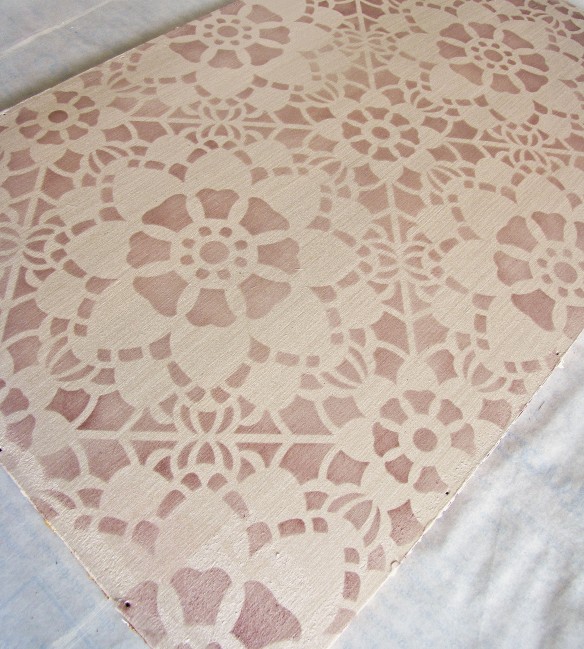 Do you see any blobs of paint? Any ooze under the stencil? No? That’s because I used a proper brush and a very light amount of paint. It’s not rocket science. Just use the right brush for the project, and don’t go heavy with the paint.
Do you see any blobs of paint? Any ooze under the stencil? No? That’s because I used a proper brush and a very light amount of paint. It’s not rocket science. Just use the right brush for the project, and don’t go heavy with the paint.  When all the pieces were painted and pretty I put them together. The metal screen didn’t need to be painted, I just sanded off the dullness before attaching it to the backboard. The screen and the knobs were attached with bolts after I drilled holes in the board.
When all the pieces were painted and pretty I put them together. The metal screen didn’t need to be painted, I just sanded off the dullness before attaching it to the backboard. The screen and the knobs were attached with bolts after I drilled holes in the board. 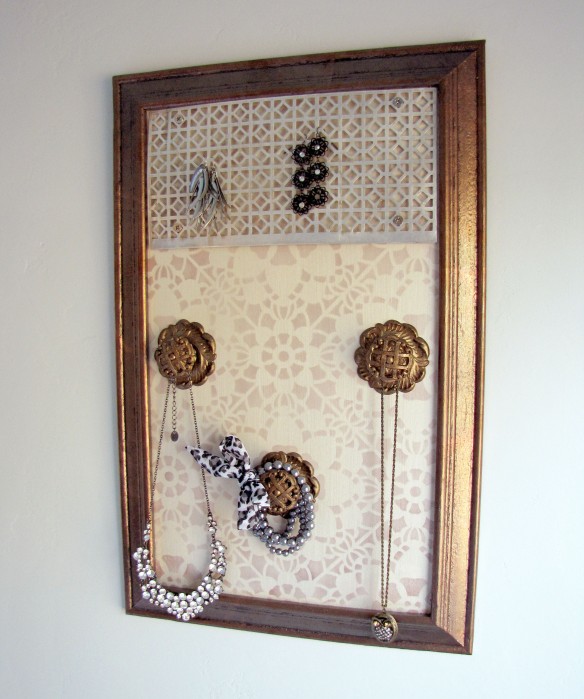 So from pieces of junk I created a great place to organize jewelry. I love how it all came together. It’s for sale in my Etsy shop now if you know anybody that could use a little help with corralling their accessories. This was so fun, I may have to make another one. Inventory used: Metallic paint
So from pieces of junk I created a great place to organize jewelry. I love how it all came together. It’s for sale in my Etsy shop now if you know anybody that could use a little help with corralling their accessories. This was so fun, I may have to make another one. Inventory used: Metallic paint
Tag Archives: metallic paint
How-To Paint a Ceiling Medallion
 I have always wanted to paint one of these decorative ceiling medallions and last week an old client of mine handed me an unfinished one simply asking me to “do my magic.” I was all over it.
I have always wanted to paint one of these decorative ceiling medallions and last week an old client of mine handed me an unfinished one simply asking me to “do my magic.” I was all over it.
 If you haven’t seen these you can find them almost anywhere that sells lighting. This one came from Home Depot and is made of foam. They come primed and ready to paint.
If you haven’t seen these you can find them almost anywhere that sells lighting. This one came from Home Depot and is made of foam. They come primed and ready to paint.
 I chose to use Modern Masters metallic paint in the color Brass which coordinates with the other fixtures in the room where this will be installed. The glazing brush I’m using came from Pierre Finkelstein’s collection and is perfect for getting into the nooks and crannies on this piece.
I chose to use Modern Masters metallic paint in the color Brass which coordinates with the other fixtures in the room where this will be installed. The glazing brush I’m using came from Pierre Finkelstein’s collection and is perfect for getting into the nooks and crannies on this piece.
 Metallic paint will show brush marks if you try to simply brush it on, making it look streaky. It’s best to use a stippling, pouncing motion to not only get the paint in the crevices but to also give the paint a more even finish. This paint is a little transparent so it required three coats.
Metallic paint will show brush marks if you try to simply brush it on, making it look streaky. It’s best to use a stippling, pouncing motion to not only get the paint in the crevices but to also give the paint a more even finish. This paint is a little transparent so it required three coats.
 When the three coats of brass were on I painted the inside and outside rings with two coats of an off white latex paint. The latex was in a satin finish which is important because I planned on glazing it. If I had painted it with craft paints or matte latex the glaze wouldn’t work properly and the piece would end up too dark and splotchy.
When the three coats of brass were on I painted the inside and outside rings with two coats of an off white latex paint. The latex was in a satin finish which is important because I planned on glazing it. If I had painted it with craft paints or matte latex the glaze wouldn’t work properly and the piece would end up too dark and splotchy.
 The chandelier that will hang under this medallion is chrome and glass, so I decided to add aluminum leaf on one part of the molding and on a couple small pieces on the inside carving. The first step in applying leaf is applying a liquid size which is very runny so I taped off the ring to prevent the size from dripping where I didn’t want it to go.
The chandelier that will hang under this medallion is chrome and glass, so I decided to add aluminum leaf on one part of the molding and on a couple small pieces on the inside carving. The first step in applying leaf is applying a liquid size which is very runny so I taped off the ring to prevent the size from dripping where I didn’t want it to go.
 I use Rolco Aquasize because it’s water based and dries faster. Traditional oil-based size takes forever to tack up. I buy the metal leaf from Royal Design Studio, which is really close to my house and has a great selection. You can buy online from them as well.
I use Rolco Aquasize because it’s water based and dries faster. Traditional oil-based size takes forever to tack up. I buy the metal leaf from Royal Design Studio, which is really close to my house and has a great selection. You can buy online from them as well.
Apply the size in thin layers with a soft brush. The size is the consistency of water so there’s really no way to put on a thick coat. It takes 25 minutes to dry and get tacky. If after 25 minutes it’s not tacky enough, put on one more thin coat.
A quick note on metal leafing: True metal leafing is an art form that takes years to master and pristine tools and environments. What I’m describing here is what I call Crafter’s Leafing. I’m just gluing on shiny metal. I’m breaking every rule of leafing, and I’m fully aware, so there’s no need to point it out.
 Metal leaf comes in square sheets and is lighter than air, so don’t do this outside or near an open window, or while you’re blow drying your hair. Simply lay a piece of leaf over an area with size. It will stick immediately.
Metal leaf comes in square sheets and is lighter than air, so don’t do this outside or near an open window, or while you’re blow drying your hair. Simply lay a piece of leaf over an area with size. It will stick immediately.
 I used a small soft brush to press the leaf into the crevices. Don’t press it with your fingers because the oil on your hands can discolor the leaf.
I used a small soft brush to press the leaf into the crevices. Don’t press it with your fingers because the oil on your hands can discolor the leaf.
 When all the leaf is on, burnish or rub softly with a sheepskin pad. This will even out the sheen and remove any little flakes lying around.
When all the leaf is on, burnish or rub softly with a sheepskin pad. This will even out the sheen and remove any little flakes lying around.
 If there are places where the leaf is missing, it just means you missed a spot when you were applying size. That’s easy to do when working with light colors because the size is transparent. Apply more size to the spot and add leaf when it’s tacky. It will blend in when you burnish it.
If there are places where the leaf is missing, it just means you missed a spot when you were applying size. That’s easy to do when working with light colors because the size is transparent. Apply more size to the spot and add leaf when it’s tacky. It will blend in when you burnish it.
 After I burnished the leaf I noticed that it had left grey smudges along the edges. I touched it up with the latex paint before moving on to the next step.
After I burnished the leaf I noticed that it had left grey smudges along the edges. I touched it up with the latex paint before moving on to the next step.
 I wanted to age the whole piece so I mixed up a very dark glaze and applied it heavily in small sections. Don’t glaze the whole piece at once or the glaze will dry before you can rag it off.
I wanted to age the whole piece so I mixed up a very dark glaze and applied it heavily in small sections. Don’t glaze the whole piece at once or the glaze will dry before you can rag it off.
The glaze I use isn’t readily available to DIY people, but if I could give you a recipe I would tell you to go to an art supply store and pick up Golden’s Acrylic glaze and Van Dyke Brown fluid acrylic. I would mix one part pigment to six parts glaze. Always test it before slopping it on the whole piece.
 Once you get the glaze on a section, remove it from the high points with a soft rag. Leave the glaze in the crevices.
Once you get the glaze on a section, remove it from the high points with a soft rag. Leave the glaze in the crevices.
 I use a soft hake brush to stipple the glaze in the low flat areas. It evens out the glaze, blends it with the adjoining section and gets rid of smears. Work in small sections around the piece, glazing the outside molding last. Acrylic glazes take 24 hours to dry completely and may take even longer where the glaze puddles in the crevices.
I use a soft hake brush to stipple the glaze in the low flat areas. It evens out the glaze, blends it with the adjoining section and gets rid of smears. Work in small sections around the piece, glazing the outside molding last. Acrylic glazes take 24 hours to dry completely and may take even longer where the glaze puddles in the crevices.
 I love how the glaze settled in the outside molding. It took just enough shine off the aluminum leaf to make it pretty and not garish.
I love how the glaze settled in the outside molding. It took just enough shine off the aluminum leaf to make it pretty and not garish.
 So there it is. I’ll post a picture of it when it gets hung with the chandelier. They’re really happy with it and I had a lot of fun painting it. Now it’s your turn!
So there it is. I’ll post a picture of it when it gets hung with the chandelier. They’re really happy with it and I had a lot of fun painting it. Now it’s your turn!
A small note: this didn’t end up being the final product thanks to the client’s wanting more metal leafing. Please go to this post to see the real final product.
